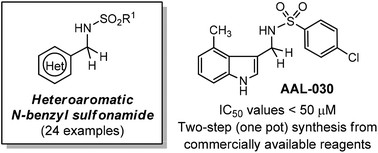Synthesis and identification of heteroaromatic N-benzyl sulfonamides as potential anticancer agents†
Abstract
Sulfonamides are a crucial class of bioisosteres that are prevalent in a wide range of pharmaceuticals, however, the available methods for their production directly from heteroaryl aldehyde reagents remains surprisingly limited. A new approach for regioselective incorporation of a sulfonamide unit to heteroarene scaffolds has been developed and is reported within. As a result, a variety of primary benzylic N-alkylsulfonamides have been prepared via a two-step (one pot) formation from the in situ reduction of an intermediate N-sulfonyl imine under mild, practical conditions. The compounds have been screened against a variety of cell lines for cytotoxicity effects using a Cell Titer Blue assay. The cell viability investigation identifies a subset of N-benzylic sulfonamides derived from the indole scaffold to be targeted for further development into novel molecules with potential therapeutic value. The most cytotoxic of the compounds prepared, AAL-030, exhibited higher potency than other well-known anticancer agents Indisulam and ABT-751.

- This article is part of the themed collection: Synthetic methodology in OBC


 Please wait while we load your content...
Please wait while we load your content...